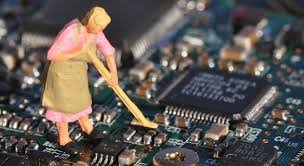Last Updated on March 4, 2024 by Nasir Hanif
If your PCB is used for industrial electronic equipment, when the PCB manufacturing is completed,a low volume high mix PCBA service is required to form a complete circuit board, it requires PCBs have several components soldered to ensure a good flow of energy. In case of failure of any part, the board may not perform its function efficiently. Hence, there is a need to replace it without damaging the board.
There are several methods to remove the components. The choice of method of removal is according to the needs. There should be minimal destruction of surrounding components on the PCB.
This article will discuss different methods of removing the components from the Printed Circuit Board.
Table of Contents
Tools to Remove the components:
Desoldering the components uses a variety of methods and tools. Here are a few examples.
Heating gun
The heating gun provides heat to the solder and melts it. However, it could be challenging to remove the component before it cools because the solder cools down quickly. It might also melt the solder of the surrounding components.
Desoldering tweezers:
The tweezers heated up to a specific temperature are used to pinch out the component. The pincer ends of the desoldering tweezers work as soldering iron. They are used to remove tiny parts. The temperature of the tweezers plays a significant role in reusing the removed component.
Cutting pliers:
These are small, sharp pliers used to cut off the components from the board. This technique may destroy the removed part.
Solder wick:
A thin copper wire twisted into a braid is known as the solder wick. It is also called the desoldering braid. The solder melts when the tip of the soldering iron is placed on it. The solder wick absorbs the solder when it is pressed against the solder. It is a convenient and easy tool to remove through-hole components. The surface components may not be removed efficiently using this method.
Desoldering pump and compressed air:
The desoldering pump creates suction through which the melted solder is aspirated. It is not a preferable technique. The compressed air method is messy. It is an efficient method in which the melted solder is expelled using the blast of air. The component is not destroyed and can be used again. It might lead to the destruction of the other components on the board.
Flux cleaner:
Once the desired component is removed, it is necessary to clean the board. The remaining solder and flux cause trouble while fixing a new component to the board. A flux cleaner helps to clean the board for any remaining flux.
Tips for efficient component removal:
Maintaining a clean soldering iron tip is very important when desoldering any component. Poor heat conduction would result from the burnt flux remaining at the tip of soldering iron.
When desoldering, excessive heat might cause the board and other components to be destroyed. Brittle solder junctions could also result from it. To effectively remove components, a sufficient amount of heat must be applied.
To avoid the removal of unwanted solder, the width of the solder wick should be appropriate. A thin desoldering braid also leads to inefficient removal of solder.
After the component removal, there is a need to protect the board against corrosion. A suitable flux cleaner is chosen to clean the board. The board is slightly tilted to allow all the residues to run down. The board may also be gently scrubbed and then rinsed. The PCB is cleaned with a wipe that does not leave any fiber or lint behind.
Conclusion:
The component removal is necessary if the PCB is not working efficiently and there is a need to replace it. The most suitable method should be employed that is cost-effective and least destructive.
Read More: How to Raise Flowers for Cash.



























